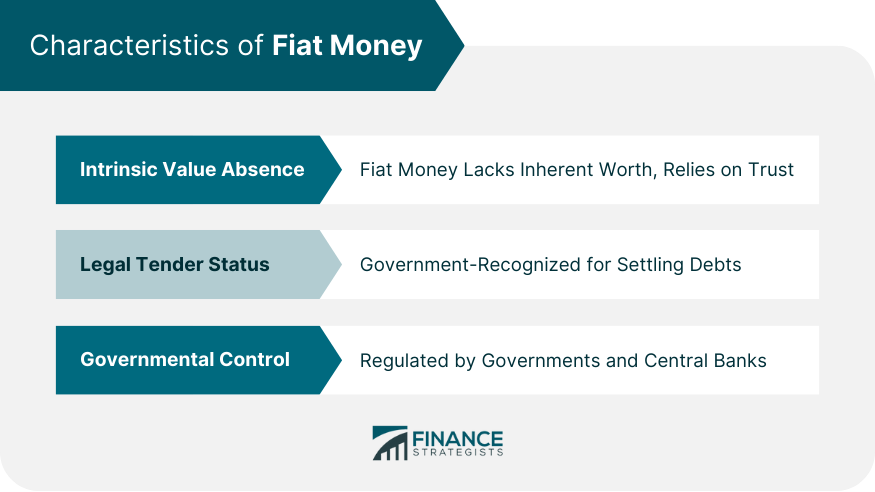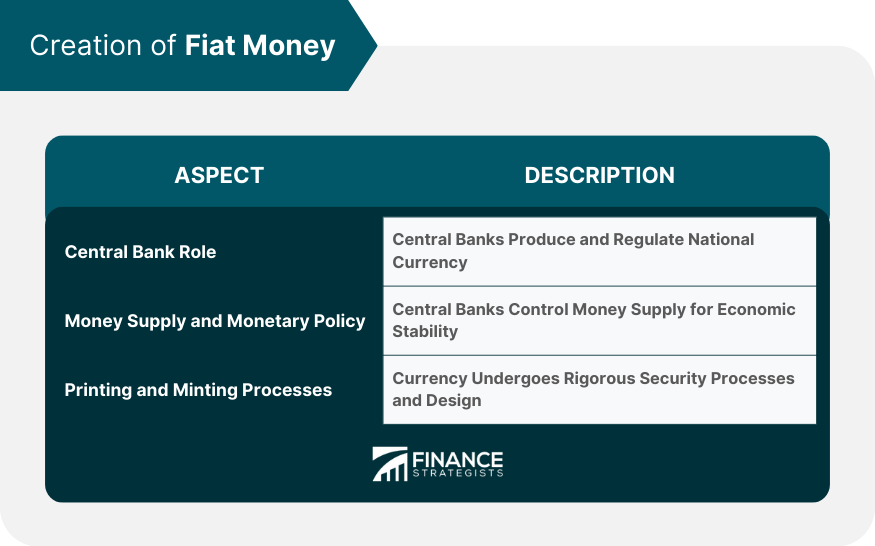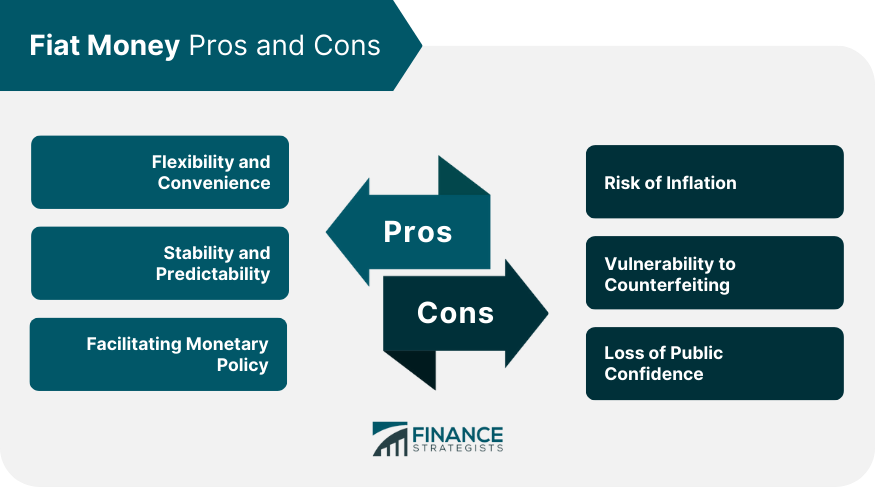Fiat money is a currency issued by a government that is backed by the authority and power of that government and its economy rather than a physical commodity. Historically, governments would mint money out of gold and silver, metals with inherent value due to their rarity and desirability. Fiat money, however, is not based on the value of any commodity. Its value exists because the issuing government has declared that it has value; hence the term "fiat", is from the Latin "let it be". The purpose of fiat money is to increase the stability of a currency and the central bank's ability to control the money supply. Before the US dollar had been severed from the gold standard, for example, people would historically hoard gold in times of economic uncertainty. This caused market shocks to be exacerbated. Gold is also an investment that typically grows more slowly and sporadically than the overall stock market; for example, since President Nixon eliminated the gold standard in the 1970's gold has seen a 460% appreciation in value, while the S&P 500 has grown by over 2,200%. The crux of fiat money is its lack of intrinsic value. Unlike a gold coin, which holds value due to its metal content, a paper note or digital number in an account doesn’t have inherent worth. It's the trust in the system and the issuing authority that propels its acceptance. This reliance on trust also means that if the confidence in the governing body or system were to wane, so could the value of the fiat money. Yet, despite this, the global trend has shifted towards fiat currencies, illustrating the faith placed in governmental monetary policy. A distinguishing feature of fiat money is its designation as legal tender. Legal tender, simply put, is any form of money that's recognized by a government as suitable for settling public or private debts. A dollar bill, for example, is used to purchase goods, pay taxes, or settle other obligations because the government mandates its acceptance. If one were to refuse a legal tender as a form of payment, they would be in breach of their obligation. The mere fact that an entity can't legally refuse fiat money as payment showcases the power and trust vested in these paper notes and digital numbers. Fiat money's existence and operations are tightly intertwined with governmental oversight. Governments, along with central banks, regulate the supply, distribution, and value of their respective fiat currencies. This control allows for responsive monetary policies, ensuring economic stability and growth. By being able to influence interest rates, manage inflation, and control money supply, governments can adapt to economic challenges swiftly. Yet, with great power comes great responsibility; mismanagement can lead to economic woes. At the heart of fiat money creation is the central bank. These institutions, whether it’s the Federal Reserve in the U.S. or the European Central Bank in the Eurozone, have the exclusive right to produce (or mint) the national currency. But it's not just about printing banknotes; it's about regulating the money supply to foster economic health. Central banks influence the creation of new money mainly through open market operations: buying and selling government bonds. By doing so, they control the amount of money in circulation, impacting interest rates and, by extension, consumer spending and saving. Monetary policy is the tool used by central banks to control the money supply. By influencing the amount of money in circulation, central banks can control inflation, manage the exchange rate, and generally stabilize the economy. A careful balance is essential; too much money can lead to inflation, while too little can stymie economic growth. This balance is maintained through various instruments like reserve requirements for commercial banks, adjusting interest rates, and employing open market operations. While the digital age has made the physical currency less pivotal, the printing and minting of fiat money remain vital. Notes and coins undergo rigorous processes to ensure durability and security. High-tech security features are embedded to prevent counterfeiting, from watermarks to security threads. These processes aren't just about security, though. The design of banknotes often carries historical or cultural significance, becoming a canvas to showcase a nation's identity. There are advantages and disadvantages of using fiat money as a primary currency. It has the advantage of being able to store value easily, being easier to keep and move around than equivalent values of gold or other resources. Because it is not based on any fixed or scarce commodities like precious metals, central banks also have much greater control over the supply of money in an economy. Without the constraints of a physical commodity backing the currency, governments can quickly adapt to economic shifts, whether expanding the money supply during a recession or contracting it during inflationary periods. Moreover, with digital transactions becoming the norm, fiat money effortlessly integrates into the technological landscape, ensuring seamless and efficient commerce. Contrary to the notion that backing by a tangible asset provides stability, fiat money systems when managed correctly, can offer greater stability. Since it's not tethered to the whims of gold or silver reserves, its value remains largely predictable and can be managed actively to respond to economic events. Such stability fosters trust, which in turn fuels investments and growth. With the right policies, economic downturns can be countered, and booms can be sustained. By not being beholden to a gold standard or another commodity, central banks can freely employ tools like interest rate adjustments, open market operations, and quantitative easing to stimulate or cool the economy as needed. Through these tools, governments can target unemployment, stabilize prices, and navigate the choppy waters of global economic events. However, despite normally being stable, if too much is minted,fiat money has the potential to bottom out and lose all value, such as with the German mark circa 1923. The following are some cons of fiat money: Since there's no physical commodity backing the currency, skeptics argue that governments and central banks might be tempted to print excessive amounts of money, leading to rampant inflation. Cases like Zimbabwe in the late 2000s serve as cautionary tales. Poor monetary decisions led to astronomical inflation rates, rendering the Zimbabwean dollar practically worthless. Despite the myriad of security features embedded in banknotes, counterfeiters continually find ways to replicate currency, leading to losses and undermining trust in the monetary system. While digital transactions mitigate some of this risk, they introduce new challenges in the form of cyber threats and digital fraud. Fiat money operates on trust. If, for some reason, the public's confidence in the government or central bank wavers, the value of the currency can plummet. Such a loss in confidence can stem from political instability, economic mismanagement, or external shocks. This fragility underscores the importance of prudent monetary policies and transparent governance to maintain the populace's faith in fiat money. Commodity money has intrinsic value. Think gold coins or cattle in ancient times. The value of commodity money stems from the commodity itself. Fiat money, conversely, derives its value from trust and legal decrees. Historically, commodity money provided a sense of security since it was tied to tangible, valuable assets. However, it lacked the flexibility of fiat money, making it challenging to respond to economic crises or to facilitate growth. Both systems have their merits and drawbacks. Commodity money, being tied to a tangible asset, can be perceived as more stable. Its value isn't easily eroded by governmental policies. Yet, it's inflexible. An economy based on a gold standard, for instance, can't easily increase its money supply to counteract a recession. Fiat money, on the other hand, offers flexibility and better tools for economic management. However, it's susceptible to inflationary risks, counterfeiting, and can collapse if public confidence wanes. Fiat money is a currency issued by a government with value derived from trust and authority, not tied to any physical commodity. Its purpose is to enhance currency stability and facilitate central banks' control over money supply. While lacking intrinsic value, fiat money offers flexibility, convenience, and stability when effectively managed. Central banks play a crucial role in its creation and regulation through monetary policies. However, the system is not without flaws, as excessive printing can lead to inflation, counterfeiting poses risks, and loss of public confidence can cause value collapse. This underscores the importance of sound monetary policies and transparent governance to maintain public faith in fiat money.Fiat Money Definition
Purpose of Fiat Money
Characteristics of Fiat Money
Intrinsic Value Absence
Legal Tender Status
Governmental Control and Regulation

Creation of Fiat Money
Central Bank Role
Money Supply and Monetary Policy
Printing and Minting Processes

Fiat Money Pros and Cons
Pros
Flexibility and Convenience
Stability and Predictability
Facilitating Monetary Policy
Cons
Risk of Inflation
Vulnerability to Counterfeiting
Loss of Public Confidence

Fiat Money vs Commodity Money
Conclusion
Fiat Money FAQs
Fiat money is a currency issued by a government that is backed by the authority and power of that government and its economy, rather than a physical commodity.
Fiat money, however, is not based on the value of any commodity. Its value exists because the issuing government has declared that it has value, hence the term “fiat,” from the Latin “let it be.”
The purpose of fiat money is to increase the stability of a currency and the central bank’s ability to control the money supply.
Before the US dollar had been severed from the gold standard, for example, people would historically hoard gold in times of economic uncertainty. This caused market shocks to be exacerbated.
Despite normally being stable, if too much is minted, fiat money has the potential to bottom out and lose all value, such as with the German mark circa 1923.
True Tamplin is a published author, public speaker, CEO of UpDigital, and founder of Finance Strategists.
True is a Certified Educator in Personal Finance (CEPF®), author of The Handy Financial Ratios Guide, a member of the Society for Advancing Business Editing and Writing, contributes to his financial education site, Finance Strategists, and has spoken to various financial communities such as the CFA Institute, as well as university students like his Alma mater, Biola University, where he received a bachelor of science in business and data analytics.
To learn more about True, visit his personal website or view his author profiles on Amazon, Nasdaq and Forbes.











